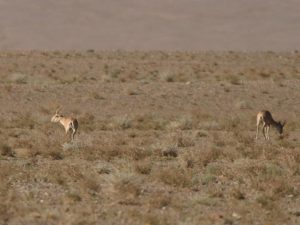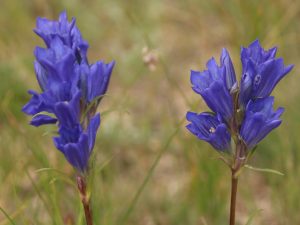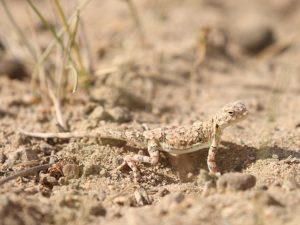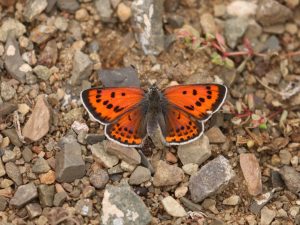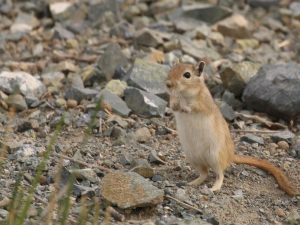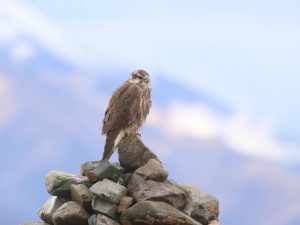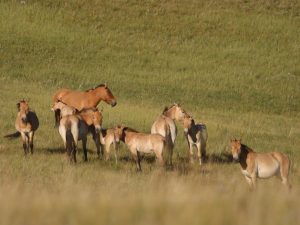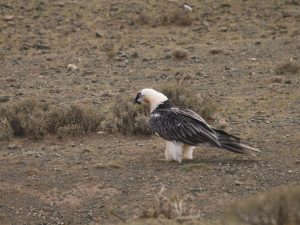
wildlife of the steppe and Altai
Snow Leopards, Przewalski’s Horses and so much more
Download leaflet
Wildlife Travel leaflet Mongolia 2026
Dates
7th – 22nd August 2026
Leader
Price
To be confirmed
Included
Return flight from the UK. Local transport as specified in itinerary including internal flight. Fourteen nights accommodation, full board. Payment to local conservation projects.
Not included
Refreshments. Gratuities. Travel insurance. Visa costs. Covid tests and associated costs.
Group size
Minimum 6, maximum 12.
We are very excited to offer an adventurous tour of this little-known but wildlife-rich country, in search of some iconic mammals amongst jaw-dropping scenery.
The undoubted highlight of this trip is the very realistic chance to see Snow Leopards, without needing to climb to uncomfortable altitudes or camp out in deep snow. We will spend much of our time up in the foothills of the Altai Mountains, where sharp-eyed local trackers help to increase the chances of a sighting, and where the presence of eco-tourists makes a positive contribution to the conservation of the mountains’ wildlife.
Other exciting mammals we will be looking for during our time in Mongolia include the famously ’grumpy’ Pallas’s Cat (present throughout the country, with sightings during all our previous visits), wild Przewalski’s Horses at a remote reintroduction site amongst stunning sand dunes, shy Siberian Ibex and Argali up in the mountains, the bizarre Mongolian Saiga in its last refuge in the flat, arid plains of western Mongolia, the inquisitive Corsac Fox, and a plethora of pikas and voles, jirds and jerboas.
Along the way we are sure to find some exciting bird life, including such mouth-watering specialities as Pallas’s Sandgrouse, Koslov’s Accentor, Pallas’s Fish Eagle, Mongolian Ground Jay, Mongolian Finch, Güldenstädt’s Redstart, Azure Tit and Long-tailed Rosefinch. The short Mongolian summer is already ending in August, and the south-bound migration of birds from across Siberia could bring almost anything our way.
For those with a spirit of adventure, Mongolia is a destination that promises some fantastic wildlife rewards.
Download trip report
Please note that holidays change, although sometimes only slightly, from year to year and previous trip reports may not reflect the planned itinerary, or other holiday details, for the current trip. Please ask us if you would like to know of any significant differences.
Day 1 A morning flight takes us from London to Istanbul and then to Ulaanbaatar (UB, Mongolia’s capital city), arriving early morning of Day 2. From the airport, we travel 130km south east, to the river-side nature reserve at Gun Galuut, pausing to admire the giant roadside statue of Genghis Khan
Day 2 and 3 The wetlands here are a breeding site for both White-naped and Demoiselle Cranes, and are as good a spot as any to look for a great variety of migrating waders and wildfowl, on occasion including the globally rare Asiatic Dowitcher, while the nearby hills are home to Gobi Argali, the big-horned wild sheep of Central Asia.
Day 4 After one last morning spent exploring the wetlands of Gun Galuut, we will head back west, to the forested slopes of Bogd Khan, in the outskirts of UB. Protected since the 12th century, this is reputed to be one of the oldest nature reserves in the world. Amongst the trees, we will look for Siberian Chipmunk and Red Squirrel, along with forest birds.
Day 5 This morning we head back to the airport and take a flight west, to the city of Khovd, the ‘gateway to the Altai’. Making our way into the foothills of the eastern Altai Mountains, and the community-run Snow Leopard Camp, tucked into the southern slopes of Jargalant Mountain. The camp is home to some of the characteristic small mammals of these mountains: Pallas’s Pika, Midday Jird and Gobi Jerboa can all be seen around the tents, while groups of Horned Lark and Pied Wheatear flit about.
Days 6 – 9 At least initially, our primary focus will be the secretive Snow Leopard. The mountain massif is home to a population of more than 30 individuals. From the camp, we head up into the mountains to join the trackers who spend their days up here, scanning the mountainsides for the sought-after big cat. We will spend our time methodically scanning the slopes for a sign of the leopards. The mountain is also home to the prey of the big cats: Siberian Ibex, Argali and Tarbagan Marmots. The birdlife at this altitude will include the handsome Güldenstädt’s Redstart and displaying Altai Snowcock, along with the chance to look for Brown Accentor, Altai Accentor, White-winged Snowfinch and Asian Water Pipit. Soaring overhead, often at surprisingly close range, Lammergeier, Golden Eagle and Saker Falcon will all do their best to distract us. Snow Leopards are famously elusive, and we will spend as much time as we need up in their mountain domain, to have a chance of seeing them. Our days in the mountains are likely to involve long periods of sitting and scanning. We may well get cold, bored and frustrated… although all will be forgotten if and when we do catch a sight of the ‘grey ghost’.
Alongside our cat quest, we will have time to explore more of the area’s wildlife. We will travel down the mountain where springs provide some of the only permanent water sources in the area, attracting birds of the arid foothills, including Mongolian Finch, Grey-necked Bunting, Rock Sparrow and Eastern Black Redstart. In rocky areas, we look for the characterful Mongolian Ground Jay, alongside Pallid Ground Squirrels, while on the semi-desert plains of Altan Teel we hope to find flocks of Steppe Grey Shrike, Asian Desert Warbler and the lovely Tuva Toad-headed Agama, an endearing little lizard. The area is also home to the Black-tailed Gazelle, one of two endangered antelopes of the region. Scattered across the plain are small plantations of poplar trees and Sea Buckthorn, where birds heading south to their wintering grounds pause to feed: we could find various warblers and flycatchers, buntings and shrikes, wagtails and pipits. We will visit a ringing station based along the Tugrug River, where local ornithologists will show us some of their recent findings ‘in the hand’.
From our mountain camp, we will also head down into the ‘Great Lakes Depression’ to explore the wetlands of Khar Us Nuur, a waterbody covering more than 1,500km². We stop at various spots along the lake shore, where dense reedbeds, wet grasslands, muddy margins and open water provide habitats for a great variety of birds. Thousands of ducks gather on the water, including White-headed Duck and Red-crested Pochard, while groups of grazing geese could include both Bar-headed and Swan Goose alongside the more familiar Greylags.
Day 10 Bidding a sad farewell to the Snow Leopard Camp, we head down onto the plains and set off eastwards. We drive across the saline steppe, cloaked in flowering Alliums, looking out for Pallas’s Sandgrouse, Greater Sand-plover and the endangered Mongolian Saiga, an iconic species of these dusty plains. We expect to stop on the shores of Durgun Lake, where we will look for Pallas’s Gull and Caspian Tern, and where we will need to check the harriers closely, as both Eastern and Western Marsh Harrier may be present. We reach an area of mobile sand dunes, beyond which lies Khomyn Tal National Park, now famous as a reintroduction site for the last of the world’s wild horses, the Takhi or Przewalski’s Horse. Once found across the grassland of Eurasia, Przewalski’s Horse was restricted to the Mongolian steppe by the start of the 20th Century, and was lost from the wild by the start of the 1960s. Brought back to Mongolia in the 1990s from European zoos, Khomyn Tal was the third site chosen for reintroductions, where 22 animals were brought from their ‘rewilding’ site in the Cevennes, France in 2004. Four more horses followed, from Prague Zoo in 2011, and there are now more than 150 wild Przewalski’s Horses in Khomyn Tal, grazing the panoramic steppe and dunes, a real conservation success story. Grazing alongside the horses we may find Mongolian Gazelle, while smaller mammals include Tolai Hare, Long-tailed Ground Squirrel, Mongolian Jird and Brandt’s Vole, in turn attracting Corsac Fox and Steppe Polecat, along with Steppe Eagle.
Day 11 After a morning spent exploring the Park and (hopefully) admiring the horses, we continue our drive north-eastwards, headed towards the low mountains of Margaz, part of the Hangay Range.
Day 12 and 13 We spend our time in the granite hills and steppe of the Margaz in search of the charismatically ‘grumpy’ Pallas’s Cat, with the help of the sharp eyes and expert knowledge of the local rangers. The remote countryside here offers us the best chance of encountering this wonderful wild cat, and the mountains are also home to Mongolia’s other cats: Snow Leopard and Eurasian Lynx. As well as the cats, the area is home to some wonderful birdlife, with Mongolia’s only endemic, Koslov’s Accentor sure to be high on our wish list, along with a chance of spotting Pallas’s Fish Eagle.
Day 14 Time to leave the mountains, and the drive to Ulaangom, the capital of Uvs province, from where we fly back to UB.
Day 15 We explore the banks of the Tuul river, birding as we go, with Azure Tit, Azure-winged Magpie and Long-tailed Rosefinch amongst our targets for the day.
Day 16 An early start sees us head back to the airport, for our flights back home.
Please note that the itinerary may be changed to suit the weather or other practicalities at the discretion of the leaders.
Accommodation
Mongolia is not a destination for those who like their luxury. But for those with a spirit of adventure who are prepared to forego some home comforts for a while, it’s a destination that promises some fantastic rewards.
Our accommodation in Ulaanbaatar will be at a clean and comfortable 3 star hotel, with private en-suite bathrooms, plenty of hot running water and mains electricity.
Elsewhere, we will be staying in local ‘ger’ camps. The ger is the traditional ‘yurt’ of Mongolian nomads, a tent/hut consisting of a single round room made up of wooden columns with walls and roof of felt and plastic tarpaulins. Each ger is furnished with two twin beds, with plenty of extra blankets available, a wash basin and heated with a wood stove.
The community-run Snow Leopard camp is situated on a flat ‘shoulder’ on the lower slopes of the Jargalant mountain, on the eastern edge of the Altai, at an altitude of 1,600m asl, with stunning views across the valley between two mountain massifs. Electricity is provided by a generator for a few hours each evening. The camp has four ‘long drop’ toilets set in a secluded area on the edge of the camp, and there are four shower rooms, with hot water available when needed. Meals are taken in the ‘restaurant’ ger.
Meals
Meals will be a mixture of international and Mongolian dishes. Traditional Mongolian cuisine includes a lot of lamb, noodles and dumplings. Requests for special diets may be accommodated.
There will be plentiful supplies of hot drinks (tea and instant coffee), sweets and snacks during the days, as well as three good meals a day.
Travel
We will be travelling by 4WD vehicles, with three people per vehicle: the vehicles will stay in contact by ‘walky talky’ radio. This may prove frustrating at times, but is the only way of accessing the remote areas we want to visit. Away from the immediate surroundings of the cities, there are very few paved roads in Mongolia. We will be ‘off-roading’ for much of our time, especially in the west of the country, where the drivers take us over bumpy ground and up/down rocky slopes to get us to where we need to be, to have the best chances of finding the wildlife.
We will take domestic flights between Ulaanbaatar and Khovd (return) with Aero Mongolia. Domestic flight schedules in Mongolia are generally not released until a couple of months in advance, and flights have a tendency to be delayed with some regularity: we have given ourselves extra time in the itinerary, should we need to change our plans at short notice, to fit in with the flights.
Group flights
Group flights are with Turkish Airlines from London Heathrow to Ulaanbaatar via Istanbul.
7th August depart London Heathrow 06.30, arrive Istanbul 12.25
depart Istanbul 18.15, arrive Ulaanbaatar 07.20 (8th August)
22nd August depart Ulaanbaatar 08.50, arrive Istanbul 13.00
depart Istanbul 14.45, arrive London Heathrow 16.40
It is also possible to fly from London Gatwick, London Stansted, Manchester, Edinburgh or Birmingham International, connecting to the same group flight in Istanbul: contact us for details.
Overland travel
Overland travel to Mongolia is possible. Contact us to find out more, and to make your holiday flight-free.
Time zone
Istanbul is two hours ahead of the UK. Ulaanbaatar is seven hours ahead of UK time. Khovd is six hours ahead of UK time.
Entry requirements
If you hold a British passport you can travel to Mongolia for up to 30 days without a visa. Your passport must be valid for at least six months on your date of entry.
Mongolia is the ‘Land of Blue Sky’, with clear skies for two-thirds of the year. Under clear skies, the days can get warm, up to 25°C with strong sunshine. Overnight, and up in the mountains, temperatures can drop down to freezing. Rain storms may pass through, turning to snow high in the mountains.
No strenuous walking is involved in this holiday, but you need to have a reasonable level of general fitness, and be happy to ’rough it’ a little, including sleeping in ger camps, travelling for extended periods by 4WD vehicle over rocky and bumpy ground, and spending days without access to ‘facilities’. The longest walk is likely to be about 4km: you may sometimes need to walk on rough or rocky ground or up/downhill. We will be visiting moderately high altitudes during our time in the Altai, perhaps reaching up to 3,000m on our excursions, although our accommodation is below 2,000m.

